Search the Special Collections and Archives Portal
Search Results
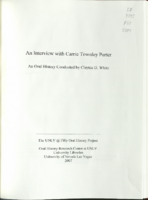
Transcript of interview with Carrie Townley Porter by Claytee D. White, February 7, 2006
Date
2006-02-07
Archival Collection
Description
Carrie Townley Porter, a 6th generation Texan, was born in Central Texas near present-day Fort Hood. Her father, a highway patrolman, was called into the Army Reserve in 1940 and spent some years moving around the country. At one point, his wife and children stayed in Belton, Texas tor three years because her father was transferred to places they couldn't go. Carrie finished high school in Austin, Texas, and attended two years at University of Texas in Austin. She left college to get married, and she and her geologist husband lived in Kansas, Oklahoma City, and Albuquerque. He took a job with the Atomic Energy Commission that required frequent trips to the Nevada Test Site, so the suggestion was made that they just move to Las Vegas. At this point they had three children with no reliable child care so Carrie became a housewife for a while. The Townleys lived a full and active life in Las Vegas and she eventually got hired as a substitute teacher. Carrie mostly subbed at Gibson Junior High School. She decided to finish her degree at Nevada Southern University (now UNLV) after her principal told her that if she could do that, he would have a job waiting for her. Several of the courses that Carrie took were Nevada history correspondence courses from UNR. These courses were prepared and graded by Dr. Russell Elliott. Carrie also fondly remembers two Nevada Southern history professors in particular, Dr. John Wright, whom she considered a mentor, and Rosemary Masick, who taught English history. After receiving her bachelor's, Carrie returned to teaching math at Gibson Jr. High. She started an archaeology club on her own and she and Russ Elliott started the first Trailblazer Club (junior history) in the state. She got students involved in the history of the Native Americans in the area and took them on field trips which gave them a chance to participate in a dig. Carrie has worked in Special Collections in the UNLV library as an archivist, with Sierra Pacific Power Company as a records analyst, and at Caesar's Tahoe as records administrator. She has also been very deeply involved with the Nevada Women's History Project since 1994. This group was responsible for the Sarah Winnemucca Statue Project, which placed a statue of this Native American in Washington, D.C., and a copy of it in the capitol building in Carson City. Today Carrie is doing a collaborative book on Helen J. Stewart with Sally Zanjani. She has done extensive research on Helen Stewart's life, and to this day makes "living history" presentations dressed as Helen J. Stewart. In addition to her history commitments, Carrie still holds onto her records management consulting firm, which she started in 1985.
Text
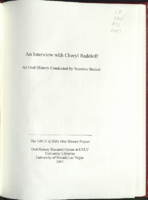
Transcript of interview with Cheryl Radeloff by Suzanne Becker, July 27, 2006
Date
2006-07-27
Archival Collection
Description
Dr. Cheryl Radeloff was born in Dayton, Ohio, and grew up in Beavercreek, Ohio, in the '60s. She graduated from Beavercreek High School and attended Bowling Green State University, where she earned a Bachelor of Arts degree in popular culture with a minor in women's studies. Cheryl's early work history included retail, an externship with the Children's Museum of Indianapolis, and a stint as a docent. After that she volunteered for Planned Parenthood of Miami Valley in Dayton, doing information gathering. She was offered a job working as an HIV educator /counselor for the organization, and learned to assist with basic procedures and do blood draws. Ms. Radeloff received her master's degree in sociology from the University of Toledo in 1996, and heard about a research position at UNLV. She contacted Dr. Maralee Mayberry and Dr. Peg Rees of the UNLV sociology department and was hired as a graduate assistant through Promise (Projects for Interdisciplinary and Multi-cultural Study in Education). Cheryl got involved in GSA and served as both a representative and as president (1999-2001) of that organization. She sat on many committees in this capacity and also counseled graduate students and listened to their suggestions and complaints. At the same time she was doing research for her dissertation and teaching classes. Cheryl received her PhD in 2004. The American Sociological Association Job Employment Fair in 2005 provided a forum in which her knowledge and experience as a social and health policy expert could be sought out by prospective institutions.
Text
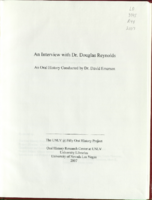
Transcript of interview with Dr. Douglas Reynolds by Dr. David Emerson, June 16, 2006
Date
2006-06-16
Archival Collection
Description
Professor Douglas Reynolds joined the engineering faculty in 1983. His credentials include a B.S. from Michigan State, M.S in mechanical engineering from Purdue, and a PhD in the same field, also from Purdue. Dr. Reynolds' work experience includes an assistant professorship at University of Texas a Austin (architectural engineering), associate professor in mechanical engineering at University of Pittsburgh, and a stint of industrial experience working for Caterpillar Tractor Company. He also worked as an acoustical consultant in Dallas, Texas. When interviewed at UNLV, Doug sensed that this was an opportunity to get in on the ground floor of a new engineering program and really have an impact on its development. He worked on the Engineering Advisory Committee and was given the task to justify the existence and growth of the engineering program at UNLV. He presented a report which documented the size and cost of the engineering building, and that report led to the existence of the building that can be found on campus today. With the building under construction, the engineering program itself needed accreditation with the American Board of Engineering and Technology. Dr Reynolds was responsible for documenting past, present, and future plans for the department courses and degrees. He also had to document a legitimate student graduation in order to apply tor accreditation. All this was accomplished in a short time, and the school received a very high evaluation. Dr. Reynolds' primary specialty is mechanical vibration and acoustics. He teaches machine design, kinematics and dynamics, and courses in mechanical vibration and acoustics. He wrote a textbook in the early 80's, "Engineering Principles of Acoustics." The updated revision will be completed soon, and he is also writing a new text entitled "Engineering Principles of Vibration". Douglas is chief U.S. delegate and chairman of the U.S. technical advisory group for ISO (International Standards Organization). He logs thousands of air miles every year on trips that are basically directed to research, bringing in research dollars, or are related to the standards work he does. His efforts on such a broad scale bring the UNLV engineering school national and worldwide exposure.
Text
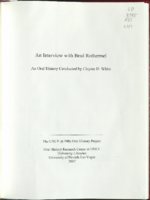
Transcript of interview with Brad Rothermel by Claytee D. White, July 31, 2006
Date
2006-07-31
Archival Collection
Description
Dr. Brad Rothermel gives a brief introduction to his childhood days in Monroe Center, Illinois. He was born into a family of educators, so it was natural that he completed a Bachelor's, and finally a doctorate. He attended Northern Illinois University in De Kalb for his undergraduate degree and the University of Illinois for his Master's and PhD. Dr. Rothermel's work history before arriving at UNLV in 1981 includes coaching in the Chicago Cubs organization and stints at Kansas State and West Virginia University as athletic director and business manager. He describes how he came to apply at UNLV and comments at length on the responsibilities of an athletic director. Brad goes into minute detail discussing the history of the athletic programs at UNLV. His memories of coaches, players, and memorable wins are as compelling as his descriptions of fundraising, an average day as athletic director, and outstanding figures in the UNLV sports scene. After retiring in 1990, Brad's association with UNLV sports did not end, but rather evolved into consulting, developing, and fundraising. He and his wife Suzanne continue to enjoy and appreciate their involvement with community, the university, and their children and grandchildren.
Text
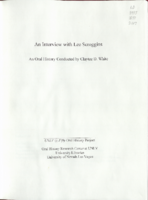
Transcript of interview with Lee Scroggins by Claytee D. White, February 27, 2009
Date
2009-02-27
Archival Collection
Description
From a Montana childhood filled with memories of sub-zero winters to a whirlwind courtship and wedding to her husband of over three decades, Lee Scroggins brought an energy to all her administrative positions at UNLV. Lee and her family moved to Las Vegas in March 1980. Within a couple of months she was working at UNLV and except for a brief hiatus in the late 1980s she remained at the university until her retirement in 2009. She gives an account of her journey through the office staff levels she held. It began with a brief stint in the Education department (you couldn't rise a level until you had six months in one position); took her to the Business and Economics departments; the 1980s. After her hiatus from 1985 to 1988, she returned to UNLV to work in the Psychology department and eventually to the library. Her interview traverses the evolution of the administrative worker from a time without technologies that became the common tools. It was an era without many copy machines, no Xerox, or computers. In addition, Lee touches upon procedural changes that were inevitable as the university grew In retirement, Lee plans to "call her own shots" and enjoy life.
Text
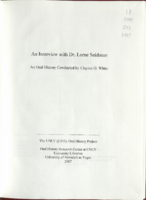
Transcript of interview with Dr. Lorne Seidman by Claytee D. White, November 14, 2006
Date
2006-11-14
Archival Collection
Description
Lawrence Seidman grew up in Cleveland, Ohio. He attended Culver Military Academy the first three years of high school, but graduated from Bay Village High School. He earned a bachelor's degree in business administration, and went on to law school at Case Western Reserve University. Lawrence and his wife moved to Chicago after he finished law school, where he worked in the First National Bank of Chicago doing estate planning and analysis. He wanted to try teaching, so he sent letters to many different schools. Ferris State College in Michigan gave him an interview, and he and his wife moved there for one academic year. The freezing cold winter convinced them that they did not want to stay in the Midwest, so Lawrence began writing letters to schools out west. UNR replied to the letter they received, saying they had no openings, but he might try Nevada Southern University in Las Vegas. The school was in the middle of changing its name to University of Nevada Las Vegas (UNLV). Lawrence flew out, interviewed with future colleagues, and accepted the job. He and his wife have lived in Vegas ever since 1969. Lawrence was the first full-time person hired to teach business law. He restructured the way the courses were developed and presented. A discipline officer was needed after the regents passed a new code of conduct and he was asked to take the position, which he did. Because the administrative or discipline officer reports to the president of the university, he got to know several of them rather well. Eventually, Lawrence became assistant general counsel, and also served as deputy attorney general for a while. His wife Janet pursued her degrees at UNLV, taught for about five years, and then worked at Children's Behavioral Services. Today they are both retired, and are enjoying traveling and working on their home. Lawrence occasionally teaches summer sessions at UNLV.
Text
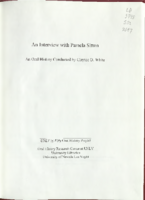
Transcript of interview with Pamela Sitton by Claytee D. White, February 27, 2009
Date
2009-02-27
Archival Collection
Description
Pamela Sitton’s childhood stories follow her construction worker father’s journey from one job to the next. She learned to adjust to a family move at a moment notice, to play in the back of a pickup truck and lived in a series of trailer homes. Finally in 1963, they moved to Las Vegas, where her father worked at the Test Site. For Pam, it was a chance to finish her schooling in one town. She attended the original Las Vegas High School and then UNLV, where she earned a degree in English literature. She recalls the Vegas of the 1960s for her unique perspective—a time of war protests, working a series of part-time jobs from cocktail waitress to post office worker, and her path to marriage in 1973. A position at UNLV’s library had been a dream job that she finally achieved when hired in 1974 as a member of the circulation staff. She held various positions throughout the library and remembers the various library buildings as a student and a professional.
Text
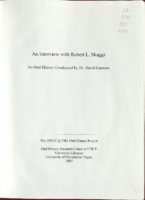
Transcript of interview with Robert L. Skaggs by Dr. David Emerson, May 06, 2006
Date
2006-05-06
Archival Collection
Description
Dr. Robert Skaggs grew up around the St. Louis area. His father was a teamster with a milk delivery route, tried his hand at the restaurant business, and during WWII worked tor U.S. Cartridge. Several members of Dr. Skaggs's family were teachers, including his grandmother and a couple of aunts. Robert graduated trom Normandy High School and afterwards attended the Missouri School of Mines and majored in metallurgical engineering. He graduated in 1954 and went to work tor DuPont tor two years. He went to graduate school at Iowa State on an Atomic Energy Commission scholarship, and afterwards was hired by Standard Oil of California. During this time he met and married Anna Pedersen (1961) and moved to Minneapolis to work for Honeywell. Around 1966, Bob started teaching at the University of Kentucky. After a couple of years, he got wind of teaching opportunities at the Southern Division of the University of Nevada (now UNLV), and interviewed with Herb Wells. He and his family moved to Boulder City (1969) and he began teaching at what is now UNLV. He was involved in the work bringing accreditation to the engineering department, establishing a chapter for Tau Beta Pi, the Engineering Honor Society, and building a master's and a PhD program. After a heart attack in 1975, Dr. Skaggs took a sabbatical from UNLV and did some team teaching at University of Arizona in Tucson with Ray Sierka. He returned to UNLV on a half time teaching basis, and also worked for the Bureau of Mines. He was again involved in accreditation preparations and stayed to graduate a PhD student in engineering. He looks upon his experiences at UNLV as very positive and delightful.
Text
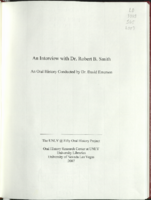
Transcript of interview with Dr. Robert B. Smith by Dr. David Emerson, June 13, 2006
Date
2006-06-13
Archival Collection
Description
Dr. Robert Bruce Smith was born in Philadelphia and spent his first two years in New Jersey, but thinks of California as home. His father's calling as a minister had taken them back east, and after his seminary training they returned to Los Angeles, followed by a five year stint in Oregon before returning to Vista, California. After high school graduation, Bob left home to attend Wheaton College in Illinois, a small Protestant school. He met his wife there and after completing his Bachelor's in chemistry they were off to Berkeley, where he completed his PhD in three years. Along the way, Dr. Smith had worked for G.D. Searle in Skokie, Illinois, and at first thought that this was his calling. His semester as a Teaching Assistant, however, convinced him that the academic life was what he wanted. Late in 1961, he learned of a job opening at the Southern Regional Division of the University of Nevada (now UNLV), interviewed with Malcolm Graham who was recruiting in San Francisco, and flew to Las Vegas to see the campus for himself. It consisted of three and a half buildings surrounded by desert. Robert's thesis director encouraged him to take the job at this new, very small college, so he and his wife drove to Las Vegas to find an apartment. They fell in love with the area and he started at UNLV as assistant professor of chemistry. He did work in organic chemistry and served as chair of the Department of Physical Sciences, as it was then called. In 1968 the department was turned into a college, and Bob became the dean of the College of Science and Mathematics. He held this position for 12 years. In 1980, Dr. Smith accepted an offer from Weber State College in Ogden, Utah, and served there as Academic Vice President (later Provost) until his retirement in 1998. He recalls with great clarity the people, changes, and events that he was involved with during the early years at UNLV. Today he and his wife enjoy their retirement in their favorite spot in the San Jacinto Mountains.
Text
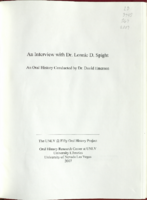
Transcript of interview with Dr. Lonnie D. Spight by Dr. David Emerson, May 8, 2007
Date
2007-05-08
Archival Collection
Description
Dr. Lonnie D. Spight grew up in northern Colorado, earned his bachelor's degree at Colorado State University, and his PhD at University of Nevada Reno. His interest in astronomy dates from his early years on the farm in Colorado, star-gazing in the fields at night. Before coming to UNLV, Lonnie worked for the Department of Defense on scattering cross sections and explosions. Working between Los Alamos and the Test Site, he was often in Las Vegas and had met most of the physicists at the university. He was invited midterm to take over a physics class for a faculty member who had fallen ill, and was offered a job the following fall of 1970. In the seventies when Dr. Spight arrived, the physics department was located in trailers, and the university campus was mostly desert. Lonnie served as chair of the department on several occasions, and was responsible for insisting that faculty members get involved in research, no matter how tight the budget. He worked on solar energy and far-field microwave analysis, and helped set up safety standards for the new laser technology. One of Dr. Spight's interests outside of physics is a love for classical music. He was a volunteer "Deejay" for 12 years with KNPR once it got started in 1980. Meanwhile, after 37 years with UNLV Lonnie retains his enthusiasm and love for teaching. Today he teaches quantum mechanics and hopes that one day he will be able to teach a particle physics course which ties together cosmology, the beginning of the universe, fundamental cutting edge physics, quarks, gluon plasmas, and more. He has the course materials ready to go and is looking forward to many more years at UNLV.
Text
Pagination
Refine my results
Content Type
Creator or Contributor
Subject
Archival Collection
Digital Project
Resource Type
Year
Material Type
Place
Language
Records Classification
